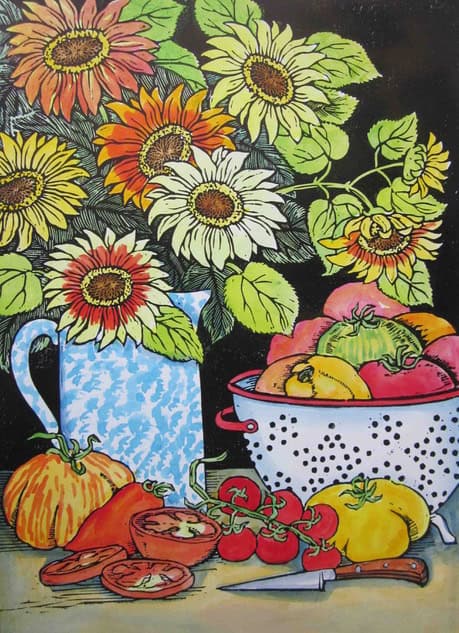
Surprises are the best part of gardening, and the finds you make when you take a chance.
Hello Everyone.
I took a chance on Verbascum Olympicum as a seedling in a six-pack last spring. Going by the brief description on the tag, this impressive wild plant is already hitting the six-foot mark. It’s a stunning display of massive grey foliage and dramatic bud that by mid-summer will be the highlight of the garden.
To see photos of Verbascum Olympicum, Clematis Roguchi, Dutchman’s pipe, Hyacinth bean (Dolichos lablab) and Petunia with Cobea scandens (cathedral bells) starting up the trellis, follow my Instagram.
Surprises are the best part of gardening, and the finds you make when you step away from the ordinary to the extraordinary are often transformative.
Most of us have the desire to improve and change the inside of our homes, yet when it comes to the outside, once planted, it’s done. Not for me. I live outdoors all summer and have a constant reel in my head about things to change. It’s not that I don’t love what I’ve created, it’s just that gardening involves constant editing. And trying new things.
I grew up at the end of a quiet road in a suburb of Boston. Mom designed the terraced walk from the driveway to the front door after reading a Better Homes and Gardens landscape book. There was a sprawling juniper, a mountain laurel, and two holly bushes, which formed the basic structure. Dad built a small pond using chicken wire and concrete, with a fountain that circulated water down a small waterfall. It was just big enough to cool off our feet and where goldfish lived, at least for a short while.
We ate outside at the picnic table, passing dinner through the open window of the kitchen. Two hammocks slung between three trees provided endless hours of swinging to cool off from the heat. Our treehouse was a simple platform with a ladder, big enough to sleep out under the stars with my sister, or a friend. We usually lasted until about midnight, then went indoors.
The landscape had everything required for beauty, yet it never really changed over time except for the occasional old tree that fell over. Everything else was simply maintained from year to year. Unlike the interior of our home, which over the 40 years we lived there was often updated with new fabrics, paint, and rugs, the backyard always remained familiar and the same.

Thinking back to this house and garden, it is like a snapshot in time. I can picture the way it made me feel walking up to the front door after school, or swinging in the backyard and cherish the comfort it instilled. If my parents had made big changes outside, perhaps the memories might not have remained as clear.
As a gardener, I believe in change outside, especially when it comes to moving plants around and trying new ones. Staying with the same plant in the same place feels stuck and a little too routine. What better place to learn to let go than in a garden?
Share Art of Growing Food Newsletter
What I like most about gardening is starting with a plan, then once planted, I edit. No major renovations, yet merely tweak the small stuff. And you’ll never hear me say “I just want to get it over with” as I might when redoing a kitchen or bath which requires hiring help.
Gardens require constant reflection, to personalize the space and allow the most striking elements to shine through. If you rush it, you might not appreciate the results as much. Time has a way of sharpening your sense of self, and accepting that your tastes change, as well as your knowledge and appreciation for a diverse range of plant materials.

This time of year, when the garden is fully planted and flourishing, go outside and look deeply at how to move things around. Some of the biggest changes you can make are the smaller things. In a kitchen, you might replace drawer and cabinet pulls, or change the color of the walls, while in a garden you might try a different type of trellis, one against the wall instead of freestanding. Or pick up a perennial that you know nothing about, yet have the curiosity to find out.
A true garden settles into a space where the garden and the home merge, a sanctuary for healthy, vibrant outdoor living mixed with wonder. Start small, edit constantly to keep it fresh, and don’t try to make the changes all at once because a garden is never fully finished.
From my garden to yours,
Ellen O.


